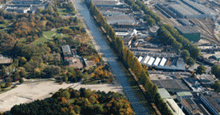
Built at the beginning of the 19th century, the Ourcq Canal provides Paris with non-drinking water. This work of art, belonging to the City of Paris' public domain of rivers, contributed to the development of an industrial area in the heart of Seine-Saint-Denis.
Hit by de-industrialisation, the neighbouring districts of this wide canal (able to accommodate 1000ton barges) are now seeking openings onto the Ourcq Canal which is seen as having a quality life style cachet. There are numerous projects for its banks, so many in fact that over the next twenty years about 50% of the buildings on its banks will be transformed. These developments have, up until now, been independent initiatives and run the risk of damaging the landscaping identity of the canal and its harmonious development and uses (leisure, transport, economic activities...).
The Apur was appointed in 2008, by its partnership work programme, to draw up a diagnosis of potential development and difficulties met (notably technical and legal). The study deals with the 12 kilometre stretch running from Pantin to Aulnay-Sous-Bois, where such issues are particularly acute. With the aim of uniting the various actors around a shared vision of the territory, the study was carried out in close collaboration with the local authorities and communities concerned, the Département of the Seine-Saint-Denis and departments of the City of Paris Council.
This study, carried out in 2008 and 2009, was presented before Councillors of Paris City and the neighbouring towns in January 2010. Its 3 volumes are available on line.
It is currently being extended by thematic workshops supported by the Apur and should culminate with a shared and coherent future for the Ourcq Canal.
